- This article is about the military of the Water Tribe. For other similar uses, see Military (disambiguation).
The military of the Water Tribe comprises the Northern Water Tribe's regular military, the Southern Water Tribe's militia, and the Foggy Swamp Tribe's forces. Due to their independence and separate location, these forces have rarely been united, and the northern and southern troops were at least once involved in a civil war.[1]
For a long time, the military of the Water Tribes was much smaller and considerably less sophisticated than that of the heavily populated Earth Kingdom or the highly industrialized Fire Nation. Each tribe had its own militia, oftentimes not well equipped and outnumbered, instead relying on knowledge of the country and the deep pride and willpower typical of a warrior race. Only after the Hundred Year War and the merging of the Northern and Southern Tribe's governments, a standing army and navy were formed under the North's leadership. However, after the Southern independence, the Southern and Northern military were divided again, now led by their respective Chiefs.[2][3]
Northern Water Tribe[]
Army (late Hundred Year War)[]
Infantry[]
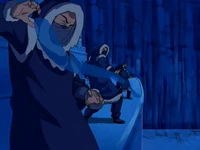
Waterbending warriors during the Siege of the North. Note their casual clothing.
The Northern Water Tribe had a robust and organized defense force even before the Hundred Year War.[4] However, it had the ability to quickly conscript civilians in times of crisis, and many adult male members of the Northern Water Tribe were fully-trained warriors, including both waterbenders and nonbenders.[2] Before the end of the Hundred Year War, there were strictly no women in the army, as it was firmly against Northern Water Tribe custom for women to learn offensive waterbending, and for nonbender women to train as warriors.[5][6] Master waterbenders who were involved in the military were referred to as "Water Warriors", and were known for being elite fighters as well as their ability to defend the ramparts of Agna Qel'a.[7] In times of war, the men gathered, receiving the traditional war paint of both Water Tribes and their weapons. Both benders and nonbenders were equipped with melee weapons including clubs, spears, scimitars, and machetes. These weapons were traditionally made of bone; the machetes for example were laced with whale teeth on the dull side of the blade. There was no standard uniform, however, as the warriors either wore their casual clothing or fabric armor. Even though their equipment, organization and number was inferior to the Fire Nation Army, the Northern Water Tribe Army was adapted to the cold climate and treacherous landscape of the North Pole. This, together with their high morale, willpower and courage enabled the warriors to successfully defend their tribe for one hundred years.[2][8]
Other equipment[]
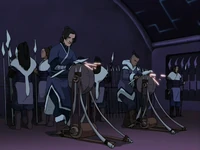
Hahn and Sokka sharpening their weapons at a Northern Water Tribe armory.
The Northern Water Tribe made use of armories located on the warrior training grounds, which served as weapon storage and war planning rooms where orders were distributed. The armories also contained grindstone wheels, which were kept in motion by pressing down on a foot pad and used to sharpen spear tips and knives. Their waterbenders engendered and utilized a countless amount of iceberg spikes scattered across the ocean just outside Agna Qel'a as a first line of defense against Fire Nation ships. The spikes were capable of ripping through solid metal and sinking even the largest ships. The currents in the iceberg fields were known to be extremely dangerous, but were easily traversed by Water Tribe vessels. The iceberg spikes themselves were also used as cover for warriors to hide behind, enabling them to easily ambush any unwanted visitors.[2]
Army (post 150 AG)[]
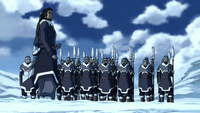
Northern Water Tribe soldiers in 151 AG.
As a result of the industrialization of the tribe after the war, the Northern Water Tribe's military changed greatly. The tribe became more reliant on its standing army, and its equipment was improved; by 151 AG, machetes and spears had become the most common weapons, but now made of metal and, in the case of the spears' shafts, of wood. A standard uniform had been introduced, consisting of thick blue-violet fabric armor, a fabric helmet, lined trousers and padded boots. Since at least 150 AG, the army also makes use of pack animals and mounts, most notably the Arctic camel and the buffalo yak.[9][10]
The standard weaponry of machetes and spears remained largely the same for twenty years, though a new uniform was introduced. Less thick and bulky, this new dark blue uniform allows greater freedom of movement. It consists of a padded jacket, a leather helmet with fabric neck guard, lined trousers and high boots.[10] If needed, the military also provides woolen cloaks for the soldiers.[11] High-ranking officers wear a dark blue coat with a Water Tribe insignia.[12] The army also gained the ability to construct massive encampments and bunker complexes, proving to be a formidable defense force.[10] However, the Northern forces also appear to be much less adapted to urban warfare, as seen during the battle of the Southern Water Tribe.[11] Soon after their invention in 170 AG, mecha tanks were employed by the Northern military as part of their ground forces.[10]
[]
By the early 3rd century BG, the Northern Water Tribe's navy was regarded as rather powerful, able to keep pirates out of the Northern Sea.[13] However, despite being a nation culturally associated with the ocean, the Northern Water Tribe's fleet was already outmatched by the Fire Nation's navy by this point.[14]
Upon the Hundred Year War's start, the Northern Water Tribe's navy battled the Fire Navy alongside naval forces from its sister tribe in the south. The Water Tribes' fleets were defeated in a series of massive battles, however, resulting in the Northern Tribe focusing its efforts on defending the North Pole and leaving the Fire Navy to dominate most of the world's oceans.[15] Nevertheless, the Northern Navy remained capable of defending its territorial waters from the Fire Navy up until the late war, something the Southern Water Tribe's naval forces failed to achieve.
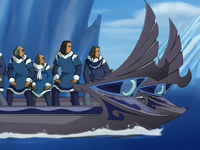
A waterbending-powered catamaran approaches after an ambush.
The Northern Water Tribe had a number of different ships by the war's later stages, the most common variant being the waterbending-powered catamaran, a small vessel with two hulls. Though its compact size enabled it to be used for a variety of applications, including transporting civilians across the canals within Agna Qel'a, its main purpose was to be used for short, open ocean trips. Even though it was not necessarily designed for long voyages, it was capable of being used to travel over a thousand miles and withstanding the harshest ocean conditions. Warriors used this ship to patrol and protect the waters just outside the Northern Water Tribe.[5]
The Northern Water Tribe also possessed larger maritime vessels. Master Pakku used such a ship, also a catamaran, to travel from the Northern Water Tribe to the Southern Water Tribe as he began his effort to restore the decimated community to its former state. The ship was massive, easily transporting scores of waterbenders and healers, all the members of Team Avatar, and a ten-ton flying bison.[16]
Within seventy years after the end of the Hundred Year War, the Northern Water Tribe constructed a much stronger navy, having gained access to capital-class battleships. These ships were used excessively during the Water Tribe Civil War, blockading the harbors of the Southern Water Tribe and transporting prisoners of war.[1]
Special task forces[]
Hahn's task force[]
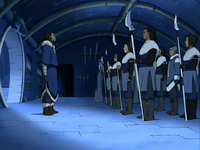
Hahn's task force.
These militants of the Northern Water Tribe were recruited when Chief Arnook called on his tribe asking for participants for a mission to stop the invading Fire Nation Navy. Sokka was one of the participants, but while training for the mission, he got into a quarrel with its leader, Hahn. He was subsequently removed from the team by Chief Arnook, although in reality it was so he could protect Princess Yue. Hahn and his team disguised themselves as Fire Nation soldiers, using authentic Fire Nation uniforms that had been acquired in 15 AG. The task force intended to infiltrate the Fire Nation Navy in order to assassinate its commander, Admiral Zhao.[2]
Hahn's task force was apparently successful in boarding Zhao's ship, but the mission ended in failure when Zhao threw Hahn overboard just as he attempted to kill the admiral.[8]
Known commanders[]
Southern Water Tribe[]
Army (late Hundred Year War)[]
Infantry[]
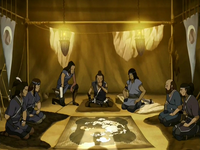
Warriors of the South discussing plans.
Almost all adult male members and some female members of the Southern Water Tribe were fully-trained warriors and combatants during the latter stages of the war.[17][18] Unlike the Northern Water Tribe, which had robust and organized defense forces, the Southern Water Tribe relied on a militia for most of its history, which was locally organized by each settlement.[4] Following the loss of their waterbenders during raids instituted by the Fire Nation, the Southern Water Tribe fighting force had shifted to a purely nonbender unit. Warrior weaponry included clubs, sharpened boomerangs, spears made of bone, scimitars, large shields and machetes lined with whale teeth on the dull side of the blade.[19] Water Tribe warriors typically apply black and white war paint to their faces before going into battle.[20] Hakoda's expeditionary force, however, used a special armor while on campaign. The armor consisted of helmets in the shape of a wolf's head and were outfitted with arm braces and greaves. The designs on their chests were different for each man. Possessing this full body armor and additional shields that could withstand small fire blasts, the Southern warriors were better equipped than the nonbending warriors of the Northern Tribe.[21]
Other equipment[]
Southern Water Tribe warriors used tangle mines, buoyant, terrible smelling makeshift mines of Hakoda's invention, which he affectionately nicknamed the "stink n' sink". The tangle mines were constructed with a bamboo frame and covered with dried animal skin, while the inside was filled with skunk fish and seaweed. These mines floated in the water and would detonated when a ship hit them. When the mines detonated, they erupted seaweed, which tangled around the propeller of the ship, incapacitating it, and skunk fish, which terrible smell forced people to abandon ship. Though a very unusual type of mine, they had apparently been quite effective.[22] Hakoda was also seen using small, handheld bombs. They appeared to be quite powerful, considering their size, only a few inches in diameter.
Southern Water Tribe rebels[]
- Main article: Southern Water Tribe rebels
After the end of the Hundred Year War, the governments of the two main Water Tribes were merged, and the Southern military was disbanded. The Northern military took over the protection of the Southern Water Tribe until the outbreak of the Water Tribe Civil War. In the course of this conflict, renegade citizens of the South formed the Southern Water Tribe rebels, committed to achieving independence from the North. Consisting of waterbenders, they had no formal equipment or uniform, but tended to disguise themselves. Under the leadership of Tonraq, a former Northern general, they became a very effective fighting force, capable of defeating regular Northern soldiers, but were unable to stand against Dark Spirits, which resulted in their eventual defeat during the battle of the Southern Water Tribe.[1][10][23]
[]
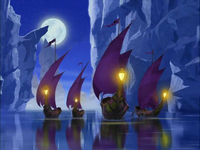
Southern Water Tribe ships in the latter stages of the Hundred Year War.
Even by the early 3rd century BG, the Southern Water Tribe was notorious for possessing almost no armed navy. As the South Pole region was located far away from any large forests, and the South lacked the economic power to import wood on a large scale, the tribe had simply no means to build ships in meaningful numbers.[13][24] As a result, the South Pole's waters became a heaven for pirates, most notoriously the Fifth Nation. One Fifth Nation leader, Tagaka, even attempted to appoint her corsair fleet as the South's de facto navy, though this plan did not succeed.[24] Earth Kingdom politician Jianzhu proposed a loan to the South so that it could build a proper military fleet, but his idea was shut down by Lu Beifong and Chamberlain Hui.[13]
By the early Hundred Year War, the Southern Water Tribe's naval forces fought the Fire Navy alongside the Northern Tribe's fleets. However, the Water Tribes were defeated. With its navy destroyed and cut off from Northern aid, the South consequently became open to attack which resulted in the catastrophic Southern Water Tribe raids.[15] By the war's end, the South had a number of cutter sailing ships with wooden hulls that utilized the wind for propulsion. The boats were operated by at least two people, one to maintain the main sail and one to control the jib, a smaller sail at the rear.[19] Just like the army, the Southern Navy was disbanded after the Hundred Year War.
Known commanders[]
Foggy Swamp Tribe[]
The Foggy Swamp Tribe has a far less organized military than either the Northern or Southern Tribes. However, its waterbenders are skilled fighters and have been involved in at least one operation, the invasion of the Fire Nation. The Foggy Swamp tribesmen use no standard uniform, instead wearing their common clothing. Because of this, their armor consists only of simple wooden chest and arm guards. While waterbending tribe members utilize bending in combat, nonbenders use spears and shields.[21] They also use small canoes which are used mostly for hunting and traveling.[25]
Known commanders[]
List of major engagements[]
- Hundred Year War
- Northern Water Tribe raids[2]
- Southern Water Tribe raids[26]
- Siege of the North[2][8]
- Invasion of the Fire Nation[21][27]
- Barbarian invasion[9]
- Water Tribe Civil War